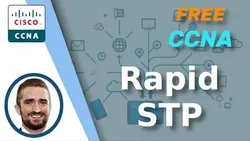
Free CCNA Rapid Spanning Tree Protocol Day 22 CCNA 200-301 Complete Course 
This course covers the Rapid Spanning Tree Protocol (RSTP), a version of the Spanning Tree Protocol (STP) used in computer networks. It compares the two versions, and explains the similarities and differences between them. It also covers the port costs, port states, and port roles of RSTP, as well as the Alternate and UplinkFast roles. ▼
ADVERTISEMENT
Course Feature
![]() Cost:
Cost:
Free
![]() Provider:
Provider:
Youtube
![]() Certificate:
Certificate:
Paid Certification
![]() Language:
Language:
English
![]() Start Date:
Start Date:
On-Demand
Course Overview
❗The content presented here is sourced directly from Youtube platform. For comprehensive course details, including enrollment information, simply click on the 'Go to class' link on our website.
Updated in [February 21st, 2023]
Introduction.
Things we'll cover.
STP Version Comparison.
RSTP Intro.
STP/RSTP Similarities.
RSTP Port Costs.
STP Port States.
RSTP Port States.
RSTP Port Roles.
RSTP Port Roles - Alternate (+UplinkFast).
RSTP: BackboneFast functionality.
UplinkFast/BackboneFast Summary.
RSTP Port Roles - Backup.
RSTP Quiz 1 (Identify Root Bridge/Port Roles).
RSTP Configuration/Verification in CLI.
RSTP BPDU (Wireshark packet capture).
RSTP Hello timer, Aging.
RSTP Link Types.
RSTP Link Types - Edge.
RSTP Link Types - Point-to-Point.
RSTP Link Types - Shared.
Things we covered.
RSTP Quiz 2.
RSTP Quiz 3.
RSTP Quiz 4.
Boson ExSim.
(Please note that we obtained the following content based on information that users may want to know, such as skills, applicable scenarios, future development, etc., combined with AI tools, and have been manually reviewed)
This course provides an introduction to Rapid Spanning Tree Protocol (RSTP) and its features. It covers the differences between STP and RSTP, port costs, port states, port roles, and BPDU packet capture. It also covers the configuration and verification of RSTP in the CLI, hello timer, aging, and link types.
Possible Development Paths include pursuing a certification in Cisco Certified Network Associate (CCNA) or Cisco Certified Network Professional (CCNP). Learners can also pursue a degree in computer science, information technology, or network engineering.
Learning Suggestions for learners include studying the fundamentals of networking, such as IP addressing, subnetting, and routing protocols. Learners should also become familiar with the Cisco IOS command line interface and the different types of network devices. Additionally, learners should practice configuring and troubleshooting networks in a lab environment.
Course Provider

Provider Youtube's Stats at AZClass
Discussion and Reviews
0.0 (Based on 0 reviews)
Explore Similar Online Courses

Wyoming Real Estate Salesperson Exam: Study Guide & Practice

CLEP Human Growth and Development: Study Guide & Test Prep

Python for Informatics: Exploring Information

Social Network Analysis

Introduction to Systematic Review and Meta-Analysis

The Analytics Edge

DCO042 - Python For Informatics

Causal Diagrams: Draw Your Assumptions Before Your Conclusions

Whole genome sequencing of bacterial genomes - tools and applications

CCNA (Cisco Certified Network Associate) Course

Packet Tracer labs for the CCNA 200-301 exam: Practical labs


Start your review of Free CCNA Rapid Spanning Tree Protocol Day 22 CCNA 200-301 Complete Course